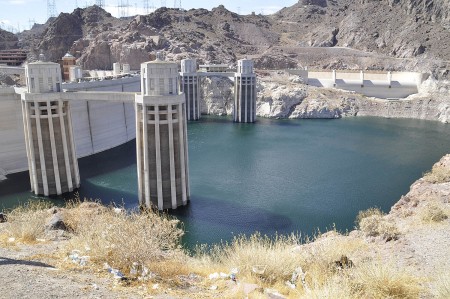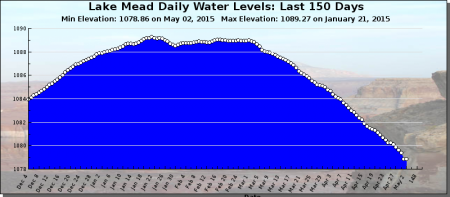May 3, 2015 – Back on April 27th I wrote a posting entitled the Colorado River Flows to Sea of Cortez as U.S. Southwest Deals with Drought. In the research for that posting I noted that Lake Mead, the largest man-made reservoir on the Colorado River was an important cog in the machinery that allowed water to be released from the American side of the border into Mexico to replenish the delta. I reported that the current surface level of Lake Mead was 372 meters (approximately 1,220 feet).
Well it turns out that the number was wrong, in fact a few months out of date. On Saturday Lake Mead’s surface level had dropped to 328.83 meters (1,078.86 feet). The levels are expected to continue to drop and when they reach 327.66 meters (1,075 feet) cities and farms drawing water from the Lake will automatically face restrictions. Las Vegas exists because of Lake Mead which provides 90% of its water. Without it the city may become unsustainable.
Why has this happened?
A megadrought that continues to impact the Southwestern United States is one reason. The other is population growth of the seven states that make up the Colorado River basin of which Lake Mead is a part. Three of those states, Nevada, Arizona and Utah grew dramatically in the first decade of the 21st century exceeding 20%. Nevada exceeded 35% in population growth. California, Colorado, New Mexico and Wyoming, the remaining four states also grew by double digits. Total increase amounted to 6.9 million, one quarter of the increase in U.S. population during the decade. Today the seven states account for 20% of the country’s inhabitants and all are experiencing freshwater stress.
The drop in Lake Mead may ignite a freshwater war between California and the states in the basin. Under past agreements California is entitled to receive 4.4 million acre-feet of water per year from the Colorado. Plagued by the drought the state has exercised its entire quota but that remains both for the short and long-term unsustainable.
Add now climate change which some scientists say may not be the only reason for the California and the Southwestern U.S. megadrought, and you have a recipe for permanent shortages for the entire Colorado River basin and its neighbours. And that means a fight over diminishing freshwater resources and possibly a dramatic reversal of the population growth in the Southwest with climate change refugees within the United States migrating to where freshwater can be found to the North and East.





















